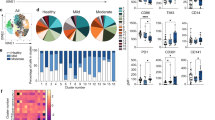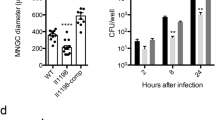Abstract
Yersinia pestis, the causative agent of plague, is known to develop strategies to overcome the host immune mechanisms and survive in the host. The molecular changes induced by Y. pestis in the host are not well delineated. Here, we examined the early events triggered after the intracellular infection of Y. pestis in human monocytes and lymphocytes by analyzing the host transcriptional profiles using cDNA arrays. We found that sets of genes that, especially at early time periods, were highly upregulated in monocytes alone when compared with a mixed culture of lymphocytes and monocytes. Gene expression responses revealed genes coding for cytokines, chemokines, transcription factors, inflammatory and apoptosis-related genes. Protein levels were measured, and real-time polymerase chain reaction was used to validate the microarray results. Our data suggest that intracellular infection of human monocytes with Y. pestis results in a strong inflammatory response at early time periods and a downregulation of genes such as thromobomodulin, which may play a role in coagulation, resulting in disseminated intravascular coagulation, a primary cause of death in plague infected hosts. We provide evidence that genomic analysis can provide a solid foundation to mechanistic insights to explain some of the symptoms induced by Y. pestis.
This is a preview of subscription content, access via your institution
Access options
Subscribe to this journal
Receive 6 digital issues and online access to articles
$119.00 per year
only $19.83 per issue
Buy this article
- Purchase on Springer Link
- Instant access to full article PDF
Prices may be subject to local taxes which are calculated during checkout







Similar content being viewed by others
References
Arbaji A, Kharabsheh S, Al-Azab S, Al-Kayed M, Amr ZS, Abu Baker M et al. A 12-case outbreak of pharyngeal plague following the consumption of camel meat, in north-eastern Jordan. Ann Trop Med Parasitol 2005; 99: 789–793.
Bengoechea JA, Lindner B, Seydel U, Diaz R, Moriyon I . Yersinia pseudotuberculosis and Yersinia pestis are more resistant to bactericidal cationic peptides than Yersinia enterocolitica. Microbiology 1998; 144 (Part 6): 1509–1515.
Hurtle W, Lindler L, Fan W, Shoemaker D, Henchal E, Norwood D . Detection and identification of ciprofloxacin-resistant Yersinia pestis by denaturing high-performance liquid chromatography. J Clin Microbiol 2003; 41: 3273–3283.
Lindler LE, Fan W . Development of a 5′ nuclease assay to detect ciprofloxacin resistant isolates of the biowarfare agent Yersinia pestis. Mol Cell Probes 2003; 17: 41–47.
Brouillard JE, Terriff CM, Tofan A, Garrison MW . Antibiotic selection and resistance issues with fluoroquinolones and doxycycline against bioterrorism agents. Pharmacotherapy 2006; 26: 3–14.
Marketon MM, DePaolo RW, DeBord KL, Jabri B, Schneewind O . Plague bacteria target immune cells during infection. Science 2005; 309: 1739–1741.
Lemaitre N, Sebbane F, Long D, Hinnebusch BJ . Yersinia pestis YopJ suppresses tumor necrosis factor alpha induction and contributes to apoptosis of immune cells in the lymph node but is not required for virulence in a rat model of bubonic plague. Infect Immun 2006; 74: 5126–5131.
Zauberman A, Cohen S, Mamroud E, Flashner Y, Tidhar A, Ber R et al. Interaction of Yersinia pestis with macrophages: limitations in YopJ-dependent apoptosis. Infect Immun 2006; 74: 3239–3250.
Cornelis GR . The Yersinia deadly kiss. J Bacteriol 1998; 180: 5495–5504.
Cornelis GR, Van Gijsegem F . Assembly and function of type III secretory systems. Annu Rev Microbiol. 2000; 54: 735–774.
Cornelis GR, Wolf-Watz H . The Yersinia Yop virulon: a bacterial system for subverting eukaryotic cells. Mol Microbiol 1997; 23: 861–867.
Straley SC, Harmon PA . Yersinia pestis grows within phagolysosomes in mouse peritoneal macrophages. Infect Immun 1984; 45: 655–659.
Sohnle PG, Hunter MJ, Hahn B, Chazin WJ . Zinc-reversible antimicrobial activity of recombinant calprotectin (migration inhibitory factor-related proteins 8 and 14). J Infect Dis 2000; 182: 1272–1275.
Roth J, Goebeler M, Wrocklage V, van den Bos C, Sorg C . Expression of the calcium-binding proteins MRP8 and MRP14 in monocytes is regulated by a calcium-induced suppressor mechanism. Biochem J 1994; 301 (Part 3): 655–660.
Huang XZ, Lindler LE . The pH 6 antigen is an antiphagocytic factor produced by Yersinia pestis independent of Yersinia outer proteins and capsule antigen. Infect Immun 2004; 72: 7212–7219.
Une T, Brubaker RR . In vivo comparison of avirulent Vwa− and Pgm− or Pstr phenotypes of yersiniae. Infect Immun 1984; 43: 895–900.
Liu F, Chen H, Galvan EM, Lasaro MA, Schifferli DM . Effects of Psa and F1 on the adhesive and invasive interactions of Yersinia pestis with human respiratory tract epithelial cells. Infect Immun 2006; 74: 5636–5644.
Welkos SL, Andrews GP, Lindler LE, Snellings NJ, Strachan SD . Mu dI1(Ap lac) mutagenesis of Yersinia pestis plasmid pFra and identification of temperature-regulated loci associated with virulence. Plasmid 2004; 51: 1–11.
Huang XZ, Nikolich MP, Lindler LE . Current trends in plague research: from genomics to virulence. Clin Med Res 2006; 4: 189–199.
Kampik D, Schulte R, Autenrieth IB . Yersinia enterocolitica invasin protein triggers differential production of interleukin-1, interleukin-8, monocyte chemoattractant protein 1, granulocyte-macrophage colony-stimulating factor, and tumor necrosis factor alpha in epithelial cells: implications for understanding the early cytokine network in Yersinia infections. Infect Immun 2000; 68: 2484–2492.
Brubaker RR . Interleukin-10 and inhibition of innate immunity to Yersiniae: roles of Yops and LcrV (V antigen). Infect Immun 2003; 71: 3673–3681.
Schrum S, Probst P, Fleischer B, Zipfel PF . Synthesis of the CC-chemokines MIP-1alpha, MIP-1beta, and RANTES is associated with a type 1 immune response. J Immunol 1996; 157: 3598–3604.
Sodhi A, Sharma RK, Batra HV, Tuteja U . Recombinant fraction 1 protein of Yersinia pestis activates murine peritoneal macrophages in vitro. Cell Immunol 2004; 229: 52–61.
Lathem WW, Crosby SD, Miller VL, Goldman WE . Progression of primary pneumonic plague: a mouse model of infection, pathology, and bacterial transcriptional activity. Proc Natl Acad Sci USA 2005; 102: 17786–17791.
Lukaszewski RA, Kenny DJ, Taylor R, Rees DG, Hartley MG, Oyston PC . Pathogenesis of Yersinia pestis infection in BALB/c mice: effects on host macrophages and neutrophils. Infect Immun 2005; 73: 7142–7150.
Parent MA, Berggren KN, Mullarky IK, Szaba FM, Kummer LW, Adamovicz JJ et al. Yersinia pestis V protein epitopes recognized by CD4T cells. Infect Immun 2005; 73: 2197–2204.
Viboud GI, Bliska JB . Yersinia outer proteins: role in modulation of host cell signaling responses and pathogenesis. Annu Rev Microbiol 2005; 59: 69–89.
Pujol C, Bliska JB . Turning Yersinia pathogenesis outside in: subversion of macrophage function by intracellular yersiniae. Clin Immunol 2005; 114: 216–226.
Wolf FW, Sarma V, Seldin M, Drake S, Suchard SJ, Shao H et al. B94, a primary response gene inducible by tumor necrosis factor-alpha, is expressed in developing hematopoietic tissues and the sperm acrosome. J Biol Chem 1994; 269: 3633–3640.
Sarma V, Wolf FW, Marks RM, Shows TB, Dixit VM . Cloning of a novel tumor necrosis factor-alpha-inducible primary response gene that is differentially expressed in development and capillary tube-like formation in vitro. J Immunol 1992; 148: 3302–3312.
Okajima K . Regulation of inflammatory responses by natural anticoagulants. Immunol Rev 2001; 184: 258–274.
Lentz SR, Tsiang M, Sadler JE . Regulation of thrombomodulin by tumor necrosis factor-alpha: comparison of transcriptional and post transcriptional mechanisms. Blood 1991; 77: 542–550.
Ohmori Y, Takahashi Y . [Thrombomodulin]. Nippon Yakurigaku Zasshi 2000; 116: 283–289.
Dahabreh Z, Dimitriou R, Chalidis B, Giannoudis PV . Coagulopathy and the role of recombinant human activated protein C in sepsis and following polytrauma. Expert Opin Drug Saf 2006; 5: 67–82.
Macias WL, Nelson DR . Severe protein C deficiency predicts early death in severe sepsis. Crit Care Med 2004; 32: S223–S228.
Yan SB, Helterbrand JD, Hartman DL, Wright TJ, Bernard GR . Low levels of protein C are associated with poor outcome in severe sepsis. Chest 2001; 120: 915–922.
Dhainaut JF, Yan SB, Cariou A, Mira JP . Soluble thrombomodulin, plasma-derived unactivated protein C, and recombinant human activated protein C in sepsis. Crit Care Med 2002; 30: S318–S324.
Sohn RH, Deming CB, Johns DC, Champion HC, Bian C, Gardner K et al. Regulation of endothelial thrombomodulin expression by inflammatory cytokines is mediated by activation of nuclear factor-kappa B. Blood 2005; 105: 3910–3917.
Nan B, Lin P, Lumsden AB, Yao Q, Chen C . Effects of TNF-alpha and curcumin on the expression of thrombomodulin and endothelial protein C receptor in human endothelial cells. Thromb Res 2005; 115: 417–426.
Schulte R, Grassl GA, Preger S, Fessele S, Jacobi CA, Schaller M et al. Yersinia enterocolitica invasin protein triggers IL-8 production in epithelial cells via activation of Rel p65–p65 homodimers. FASEB J 2000; 14: 1471–1484.
Ruckdeschel K, Harb S, Roggenkamp A, Hornef M, Zumbihl R, Kohler S et al. Yersinia enterocolitica impairs activation of transcription factor NF-kappa B: involvement in the induction of programmed cell death and in the suppression of the macrophage tumor necrosis factor alpha production. J Exp Med 1998; 187: 1069–1079.
Chromy BA, Perkins J, Heidbrink JL, Gonzales AD, Murphy GA, Fitch JP et al. Proteomic characterization of host response to Yersinia pestis and near neighbors. Biochem Biophys Res Commun 2004; 320: 474–479.
Jett M, Neill R, Welch C, Boyle T, Bernton E, Hoover D et al. Identification of staphylococcal enterotoxin B sequences important for induction of lymphocyte proliferation by using synthetic peptide fragments of the toxin. Infect Immun 1994; 62: 3408–3415.
Hinchliffe SJ, Isherwood KE, Stabler RA, Prentice MB, Rakin A, Nichols RA et al. Application of DNA microarrays to study the evolutionary genomics of Yersinia pestis and Yersinia pseudotuberculosis. Genome Res 2003; 13: 2018–2029.
Acknowledgements
This work was supported by the Defense Advanced Research Projects Agency (DARPA) and Defense Threat Reduction Agency (DTRA).
Author information
Authors and Affiliations
Corresponding author
Rights and permissions
About this article
Cite this article
Das, R., Dhokalia, A., Huang, XZ. et al. Study of proinflammatory responses induced by Yersinia pestis in human monocytes using cDNA arrays. Genes Immun 8, 308–319 (2007). https://doi.org/10.1038/sj.gene.6364389
Received:
Revised:
Accepted:
Published:
Issue Date:
DOI: https://doi.org/10.1038/sj.gene.6364389
Keywords
This article is cited by
-
Cluster analysis of host cytokine responses to biodefense pathogens in a whole blood ex vivo exposure model (WEEM)
BMC Microbiology (2012)
-
Natural selection and the molecular basis of electrophoretic variation at the coagulation F13B locus
European Journal of Human Genetics (2009)
-
Early indicators of exposure to biological threat agents using host gene profiles in peripheral blood mononuclear cells
BMC Infectious Diseases (2008)



